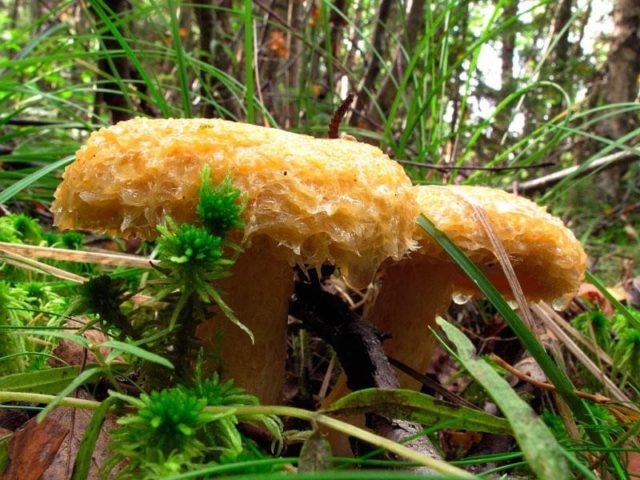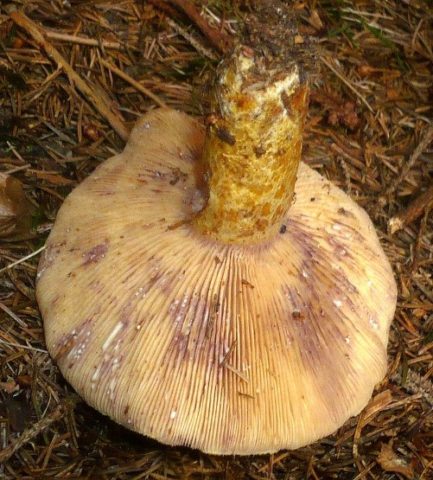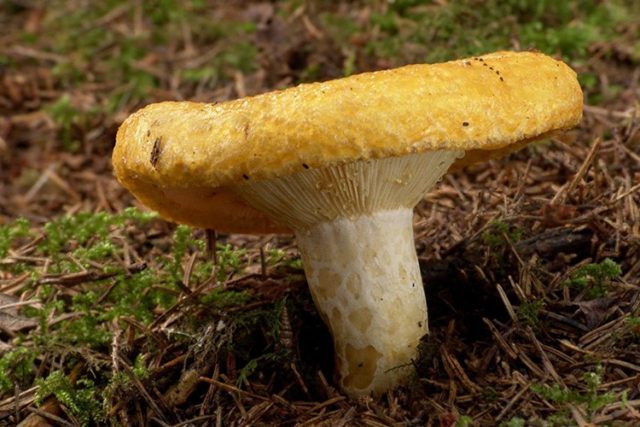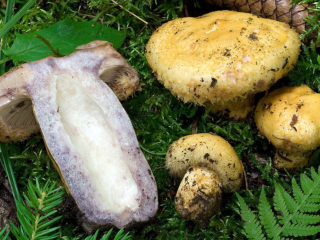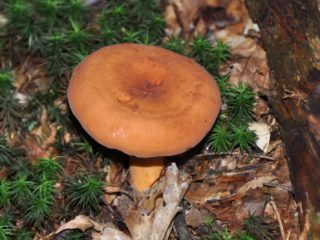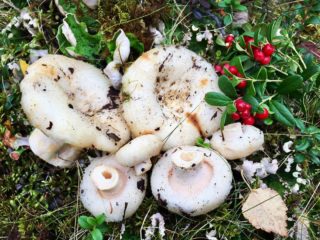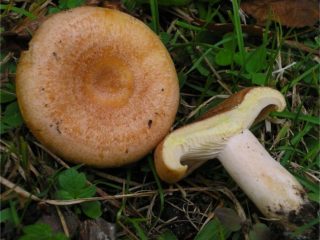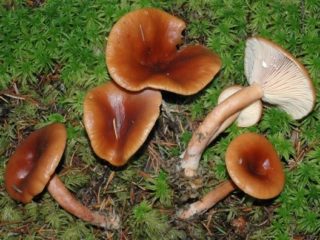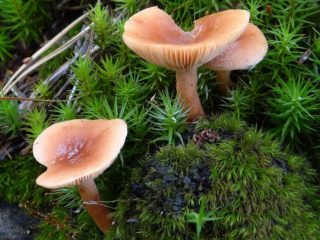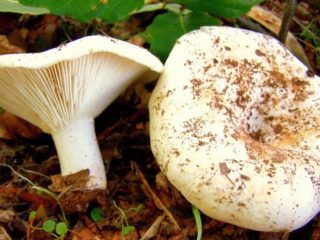Content
Blue milk mushroom scares inexperienced mushroom pickers who consider it poisonous. But experienced lovers of quiet hunting are always happy to meet this mushroom in the forest. In value it is only slightly inferior to its “relatives”.
Description of the blue milk mushroom
Belongs to the Syroezhkov family and the Mlechnikov genus. Latin name Lactarius repraesentaneus. Other names for blue milk mushroom:
- golden yellow lilac;
- violet;
- yellow turning blue;
- lilac;
- canine;
- spruce mushroom;
- representative milkman.
The epithet “dog” milk mushroom was most likely awarded for the “increased shaggyness” of young fruiting bodies.
The pulp of the dog milk mushroom is yellowish in color, dense, and slightly bitter in taste. The smell is “normal” mushroom. At the fracture, white milky juice is abundantly released, quickly turning blue upon contact with air.
Color varies from light yellow to orange-yellow. At an older age it may have a brown tint.
Description of the cap
The diameter of the cap is from 6 to 14 cm. Convex at a young age, then straightens and becomes funnel-shaped in a mature mushroom. The edges are rolled inward and pubescent. In youth, the cap is “shaggy” over its entire surface. Later, well-developed “fur” remains only at the edges. Yellow color. The skin is dry. In wet weather, sticky and slimy. There may be barely noticeable concentric rings on the surface of the cap.
Hymenophores are thin narrow plates of light yellow color with a slight purple tint. The lower ends of the plates “fit” onto the stem. The area of damage turns blue.
Description of the leg
Length 5-12 cm. Diameter 1-3 cm the same along the entire length. An option is possible when the stem expands downwards. The thickness of the leg is equal along the entire length or may increase slightly downwards. Located in the center of the cap.
In young mushrooms, the flesh of the stem is hard, but fragile. With age, the leg becomes hollow and its flesh becomes loose. The surface is sticky, with depressions. Color ranges from pale yellow to orange-yellow. With age, the stem becomes lighter than the cap.
Where and how does the blue milk mushroom grow?
In English, the representative milkman is also called:
- northern bearded;
- milk cap;
- northern milk cap.
English names to some extent indicate the distribution area of the blue milk mushroom. The southern border of the range of the representative milkweed runs along the latitude of the Vologda region. The mushroom is widespread in Eurasia, right up to the Arctic zone: it is found in Greenland and Taimyr. Common in North America.
It grows in deciduous and mixed forests, as it is a symbiont of birch, willow and spruce. Prefers calcium-poor soil. Found in groups or singly in damp places.
Fruiting season is in September.
Is the mushroom edible or not?
The blue milk mushroom almost completely lives up to the name of the family to which it belongs: Russulaceae. No, you can’t eat it right in the forest. The milky juice is too bitter. But after soaking, raw mushrooms are simply pickled without heat treatment. Many mushroom pickers even believe that these mushrooms cannot be cooked, since after heat treatment all the taste is lost. But it all depends on personal preferences. There is nothing stopping you from eating milk mushrooms boiled or fried.
No deaths were recorded. Only abdominal pain was noted. However, the substances that cause “poisoning” have not yet been discovered. With a high degree of probability, the reason is the improper preparation of the dog milk mushroom: it was not pre-soaked. Irritation in the stomach is apparently caused by the milky juice that has not been removed.
How to prepare blue milk mushrooms
The main thing in preparing dog milk mushrooms is long soaking. Depending on preference, this procedure can last from 3 to 7 days. The water must be changed at least once a day.The advantage of blue milk mushrooms is that they do not begin to ferment even after being in the water for such a long time. After removing the milky juice, mushrooms can be used based on personal preference.
Blue milk mushrooms are salted or pickled to make appetizers. Everyone has their own secrets here, but you can usually find a couple of recipes.
Pickling
One of the simple recipes:
- 2 kg of milk mushrooms;
- 3 tbsp. l. salt;
- allspice in peas;
- Bay leaf.
Spices are added to taste, but keep in mind that milk mushrooms are bitter on their own. Bay leaf also gives bitterness and there is no need to be overzealous with it.
Bay leaves are pre-crushed. The soaked mushrooms are placed in layers in a pickling container and sprinkled with salt and spices. Place a load on top and place the container in a cool place. After a week, the finished product can be put into jars and stored in the refrigerator.
Pickling
To marinate, peeled, washed milk mushrooms need to be boiled for 15 minutes in boiling water. The foam that forms on the surface is removed.
To marinate 2 kg of mushrooms you will need:
- 2 tbsp. l. salt and sugar;
- 45 ml table vinegar;
- 8 pcs. bay leaves;
- allspice peas to taste;
- several cloves of garlic;
- currant leaves;
- 2 liters of water.
Add all ingredients except vinegar to a saucepan with water and boil for 10 minutes. Place the boiled mushrooms in a 3-liter jar, pour boiling solution over it and add vinegar. Place in the refrigerator. The product will be ready in a month.
Freezing
Before freezing, milk mushrooms are boiled to remove the bitterness. Cook for an average of 15 minutes. If the milk mushrooms are large, they are boiled longer. The water is drained and the semi-finished products are allowed to cool.After this, you can put the mushrooms in the freezer.
To freeze a ready-to-eat product, mushrooms are fried with spices and salt. Subsequently, the resulting semi-finished product is used in any mushroom dish.
Doubles and their differences
Opinions differ regarding the presence of doubles in the blue milk mushroom. According to some sources, it is too original and cannot be confused. According to others, there is at least 1 double. In the photo, the blue and yellow milk mushrooms are really very similar. But when collected in the forest, it is difficult to confuse them, since the latter turns yellow and not blue at the break.
Yellow milk mushroom (Lactarius scrobiculátus)
Synonyms:
- scraper;
- yellow underboob;
- yellow wave
Color variations from light brown to yellow. There may be barely noticeable concentric circles on the cap.
The yellow podgruzd is very large. When the height of the leg is the same as that of the blue one, the cap of the yellow one can grow up to 25 cm. At a young age it is convex, later it straightens and in a mature scraper it becomes funnel-shaped. The skin can be smooth or woolly. In the second option, the yellow milk mushroom really looks like it’s turning blue. In rainy weather the cap is slimy, in dry weather it is sticky. A milky sap appears at the fracture, which turns gray-yellow in color when exposed to air.
Grows on limestone soils. This differs from the blue one, which prefers calcium-poor soil. It is found next to birch and spruce, with which the yellow cape forms mycorrhiza. Found in small groups. Distributed in northern Eurasia. In Eastern European countries and Russia, the yellow wave is considered valuable and is classified in the first category. In terms of value, the scraper is almost on par with the white milk mushroom. Some mushroom pickers even prefer yellow to white.
Collection season July-October.
Yellow, in turn, is credited with resemblance to white milk mushroom. It would be logical to assume that blue and white are very similar. But no. It's all about color variability. Yellow can be almost the same color as white, but blue cannot be.
Conclusion
Blue breast is loved by experienced mushroom pickers in the northern regions. The only bad thing is that it is rare and it is difficult to collect enough for winter preparations. But you can make assorted mushrooms.


